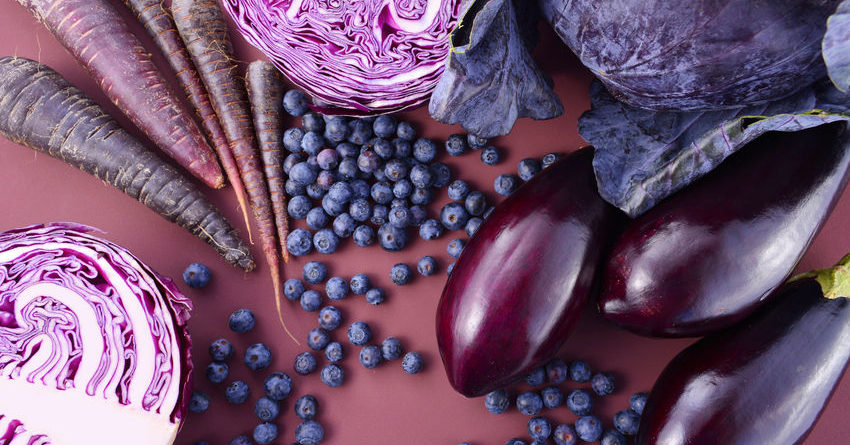Written Julie Paiva, CHHC
Most people know that filling your plate with green veggies can benefit your health, but let’s shine the spotlight on another color – purple. Purple fruits and vegetables boast plenty of nutritional credentials behind the vibrant hues. They are not only a great way of adding color to a dish, but you should feel good about eating them too. Purple foods are very high in antioxidants, like anthocyanins, which give them their beautiful shade. Many of these foods may also contain resveratrol, the anti-inflammatory compound found in red wine. You may be surprised to learn how many different heirloom varieties of popular veggies that come in purple for a healthy punch of color. There are benefits and beauty with these fruits and veggies. Just imagine how that pop of purple can really jazz up a basic weeknight meal.
Purple Sweet Potato
The benefits of these purple antioxidants in the sweet potato differ from those in the more popular orange sweet potato. Anthocyanins not only protect against free radicals, but are also believed to contain anti-inflammatory, anti-viral, and anti-cancer properties. Studies suggest that they may enhance heart health, protect against obesity, and aid in the prevention of breast cancer. The orange we see in more commonly consumed sweet potatoes represents a higher level of carotenoids, the antioxidant family that protects the eyes and supports skin health.
Wondering how to cook with them? “You can easily swap them in to a sweet potato soup, chop and roast them for a more colorful side dish. But don’t say good-bye to your good pal orange forever. Variety is key to ensure your diet includes a range of nutrients and antioxidant sources, supporting long-term health. Just alternate when possible!
Beets
Roasted, tossed in salads or blended into smoothies, beets are a nutritional powerhouse packed with vitamins, minerals and antioxidants. And if that wasn’t enough, they are even low in fat and have a sweet taste.
Purple Asparagus
Green asparagus is always a healthy addition to a balanced meal. But did you know it comes in a purple variety, too? You’ll still get the same benefits of the green version – high fiber, iron, folate, vitamin K, and diuretic properties – but you’ll also get that punch of anthocyanins for antioxidant and anti-inflammatory benefits. This asparagus is so sweet it can be eaten raw, meaning you get to enjoy all those health enhancing antioxidants to their full potential. You can roast them, along with some spices or lemon zest, for a simple side. The purple color will fade to green when heated, so if you want to preserve the vibrant hue, shave the spears and add to a salad. Purple asparagus is also great chopped and added to soups, frittatas, or stir-fry dishes.
Purple Cauliflower
No reason to stick with white cauliflower when you can have fun with a few purple florets on the plate. Purple cauliflower also packs a nutritional punch when it comes to fiber, vitamin A, vitamin C, folate, calcium and potassium and selenium. All good news when it comes to staying healthy. Cauliflower also comes in orange, which will have a few more carotenoids. You can treat purple cauliflower as you would regular – use it for a lower calorie, grain-free rice, add it to stir-fries, or use it in a casserole or gluten free pasta dish to add bulk and cut down on more calorie-dense items.
Eggplant
Eggplants are a versatile purple vegetable that can be eaten any number of ways – full of vitamins, folate, potassium, magnesium, copper, thiamine, niacin, dietary fiber and antioxidants. Plenty of reasons to put eggplant on the plate.
When choosing an eggplant, it should be firm and not too large. The length of a cucumber and the general circumference of a large pear should be about right. Smaller eggplants are less likely to be bitter (a bit of salt can help with this) and have fewer seeds, although these are edible. Eggplant can be a tad bland in its raw form. It’s usually served baked or grilled rather than raw or boiled.
Red Cabbage
Red cabbage is another awesome purple vegetable packed with antioxidants, nutrients, vitamins and minerals, as well as dietary fiber. Cabbage is tasty served raw in salads, in a stir fry or roasted.
Purple Carrots
Believe it or not, a few hundred years ago, all cultivated carrots were purple; the orange carrot wasn’t cultivated until the late 16th century. It’s unsurprising to see purple carrots sprouting up again given their stunning color coupled with their anti-inflammatory properties and antioxidants.
Blueberries
Blueberries have long been recognized as a superfood. This fruit is high in antioxidants and are delicious eaten in their natural state.
Blackberries
The rich color of blackberries is a giveaway that they have some of the highest antioxidant levels of all fruits. Rich in bioflavonoids and Vitamin C. Enjoy them naturally to benefit from their nutritional goodness.
Acai Berries
The acai berry, a naturally blueish-purple fruit, is packed with antioxidants as well as being rich in fiber, protein, vitamins A, B, C and E and mineral salts.
When making your recipes from Marpe, substitute the purple variety of these popular fruits and vegetables for the “regular” ones. You will add an unexpected pop of color and a bunch of benefits to your meal.





Benefits and Dangers of Elderberry
Thank you for providing us the list. They have several benefits and I would like to try some of them.
A pop of purple and a dose of antioxidants is exactly what I need. Thank you for this very helpful post and for listing the best food to eat hor a healthy us.
thanks for sharing these information. Nice blog indeed